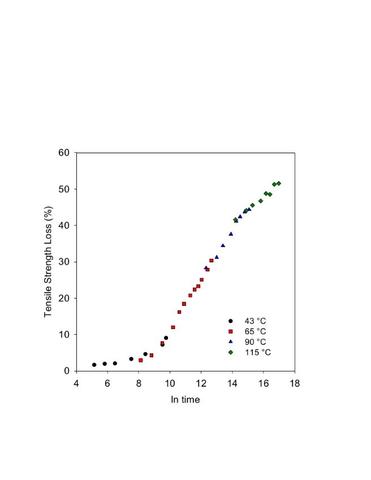Novel Measurement Tools for Interrogating Structure-Property Relationships in High Performance Materials
Understanding the ageing mechanisms that degrade high-performance materials is crucial to predicting the potential effect of environmental exposure and wear on physical, chemical, and morphological properties of common and emerging high strength fibers. Work to understand the effect of environmental conditions on high strength fibers has been ongoing since early 2004, ageing studies on specific high strength fibers have been underway since 2010.
Results: We have performed a series of studies to investigate the effect of temperature and humidity exposure on high strength fibers. These studies are summarized briefly below.
Ageing study on Ultra High Molecular Weight (UHMWPE) Fibers, a high performance material commonly used in body armor, was completed, and activation energy for thermooxidative degradation was determined to be approximately 140 kJ/mol. Results of this work were summarized in this publication: http://ws680.nist.gov/publication/get_pdf.cfm?pub_id=916161
Additional analyses on the aged fibers to include effect of ageing on molecular weight, crystal structure, and fiber morphology are underway and will be the subject of an upcoming publication.
An ageing study combining thermooxidative and hygrothermal conditions on two types of aramid fibers was completed. Results are currently being analyzed and a publication is in preparation.
Analysis of the effect of exposure to water on copolymer aramid fibers was also completed and is described in the following publication:
http://www.sciencedirect.com/science/article/pii/S0141391011002369
Related Content: Significant efforts have been undertaken by STG staff members to understand the effect of environmental exposure on body armor, and this work has been ongoing for many years. Previous significant accomplishments in this area have focused on poly(p-phenylene-2,6-benzobisoxazole), or PBO, and the development of an environmental conditioning protocol for soft body armor. This work is summarized in the following publications:
http://s3.documentcloud.org/documents/256360/forstera-pdst-2011.pdf
https://www.ncnr.nist.gov/programs/sans/pdf/publications/0599.pdf
The environmental conditioning protocol appears in NIJ Standard 0101.06 Ballistic Resistance of Body Armor:
https://www.ncjrs.gov/pdffiles1/nij/223054.pdf

Figure 1: Master curve for ageing of UHMWPE fibers at the reference temperature of 43 °C. Error bars are not shown for clarity of presentation, the standard uncertainty in the data is approximately 5 %.
Contacts
-
(301) 975-5632
Collaborators
-
(301) 975-6065

